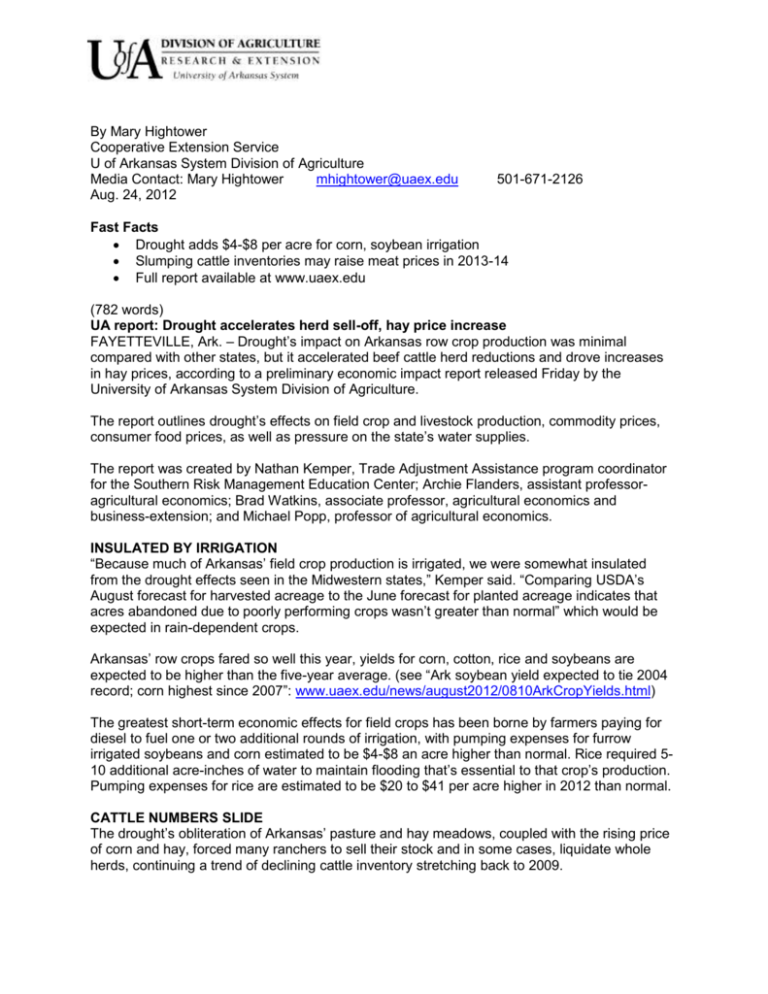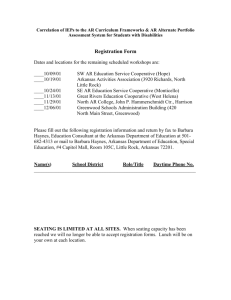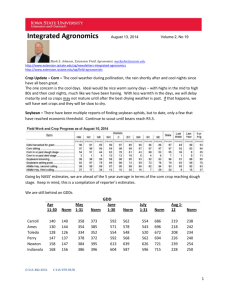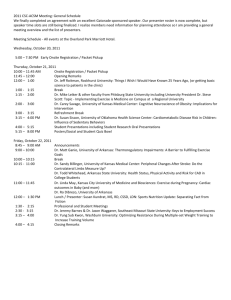UA report: Drought accelerates herd sell
advertisement

By Mary Hightower Cooperative Extension Service U of Arkansas System Division of Agriculture Media Contact: Mary Hightower mhightower@uaex.edu Aug. 24, 2012 501-671-2126 Fast Facts Drought adds $4-$8 per acre for corn, soybean irrigation Slumping cattle inventories may raise meat prices in 2013-14 Full report available at www.uaex.edu (782 words) UA report: Drought accelerates herd sell-off, hay price increase FAYETTEVILLE, Ark. – Drought’s impact on Arkansas row crop production was minimal compared with other states, but it accelerated beef cattle herd reductions and drove increases in hay prices, according to a preliminary economic impact report released Friday by the University of Arkansas System Division of Agriculture. The report outlines drought’s effects on field crop and livestock production, commodity prices, consumer food prices, as well as pressure on the state’s water supplies. The report was created by Nathan Kemper, Trade Adjustment Assistance program coordinator for the Southern Risk Management Education Center; Archie Flanders, assistant professoragricultural economics; Brad Watkins, associate professor, agricultural economics and business-extension; and Michael Popp, professor of agricultural economics. INSULATED BY IRRIGATION “Because much of Arkansas’ field crop production is irrigated, we were somewhat insulated from the drought effects seen in the Midwestern states,” Kemper said. “Comparing USDA’s August forecast for harvested acreage to the June forecast for planted acreage indicates that acres abandoned due to poorly performing crops wasn’t greater than normal” which would be expected in rain-dependent crops. Arkansas’ row crops fared so well this year, yields for corn, cotton, rice and soybeans are expected to be higher than the five-year average. (see “Ark soybean yield expected to tie 2004 record; corn highest since 2007”: www.uaex.edu/news/august2012/0810ArkCropYields.html) The greatest short-term economic effects for field crops has been borne by farmers paying for diesel to fuel one or two additional rounds of irrigation, with pumping expenses for furrow irrigated soybeans and corn estimated to be $4-$8 an acre higher than normal. Rice required 510 additional acre-inches of water to maintain flooding that’s essential to that crop’s production. Pumping expenses for rice are estimated to be $20 to $41 per acre higher in 2012 than normal. CATTLE NUMBERS SLIDE The drought’s obliteration of Arkansas’ pasture and hay meadows, coupled with the rising price of corn and hay, forced many ranchers to sell their stock and in some cases, liquidate whole herds, continuing a trend of declining cattle inventory stretching back to 2009. In Arkansas, the inventory of all cattle and calves on Jan. 1 of this year was at its lowest level in 40 years at 1.67 million. Overall, Arkansas cattle numbers have slid 13 percent since 2009. At the same time, hay prices in Arkansas have been rising since 2009, increasing 34 percent from an average of $74.50 per ton to $99.50 per ton. “Some farmers are choosing to sell calves early or otherwise trimming the size of their cow herd, which has led to some reductions in cattle prices,” Kemper said. While fed cattle prices declined more than 15 percent since May, “the outlook for beef cattle prices is positive given the current supply and demand. With the U.S. herd at its smallest size since the 1950s, high prices could be in store for cattle over the next two to three years.” A more detailed report of the effects on cow-calf operations will be done following a survey of cattle producers whose responses are due at the end of August. Economists plan to have the analysis completed by mid-September. OTHER EFFECTS Shrinking crop inventories in 2010 drove 2011 commodity prices upward for cereal and oil crops. “Prices were expected to hit a plateau this year and possibly decline,” Kemper said. “However, widespread drought in much of the U.S. corn, soybean and livestock producing areas caused commodity prices to surge.” Between the beginning of June and end of July, cash corn rose 40 percent and soybean prices rose 30 percent. However, those high prices could encourage large acreages of these crops to be grown abroad, and coupled with other factors such as lowered feed grain demand for smaller herds, could drop commodity prices in 2013. “Commodity prices are just one of the factors affecting retail food prices and make up less than 15 percent of the average retail food purchase,” Kemper said. As for the drought’s effects on consumer food prices – it’s a little early to tell. “Any effect will begin to be seen this fall,” Kemper said. USDA’s Economic Research Service “does say that it is likely we will see a slight increase above historical inflation rates and this ‘likely increase’ will be due to the drought.” WATER PRESSURE While irrigation from underground sources kept Arkansas’ crops afloat in 2012, “a long run consequence of the drought is greater pressure placed on groundwater, which is an important, but exhaustible input for the state,” the report said. Crop producers who had relied in surface impoundments wound up with dried ponds when replenishing rains failed. “These producers have been forced to use a less reliable or more expensive well, or sacrifice the crop,” Kemper said. To see the full report, visit www.uaex.edu. Find more information about drought, visit http://arkansasdroughtresourcecenter.wordpress.com/. The Cooperative Extension Service is part of the University of Arkansas System Division of Agriculture and offers its programs to all eligible persons regardless of race, color, national origin, religion, gender, age, disability, marital or veteran status, or any other legally protected status, and is an Affirmative Action/Equal Opportunity Employer. ###








